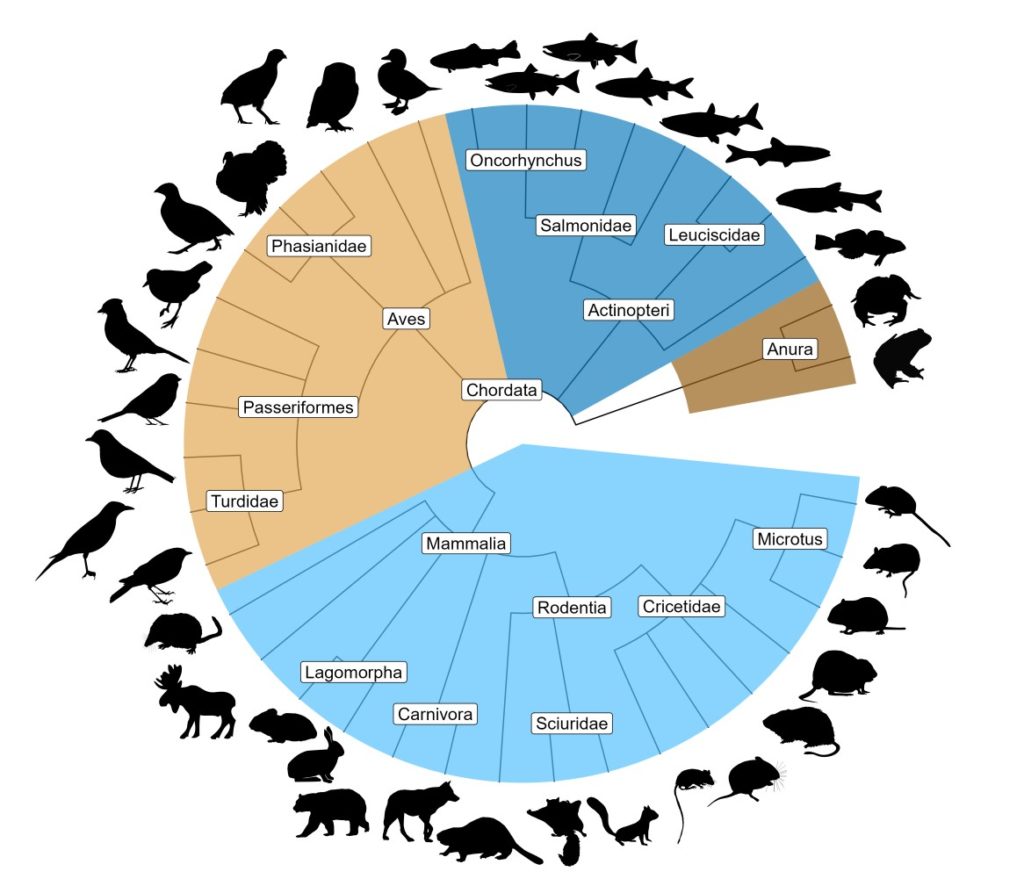
Biodiversity & Ecosystem Health Analysis
We offer a comprehensive biodiversity assessment solution encompassing sampling design, field technician training, DNA analysis, and report generation. Our approach centers around “eDNA metabarcoding,” leveraging marker genes like ribosomal and mitochondrial genes. These are amplified using CEGA’s optimized primers and sequenced on high-throughput platforms, including our in house Illumina MiSeq and NovaSeq 6000 platforms.
Our expertise spans the analysis of bulk environmental samples, including water, soil, sediments, and various biomasses like plankton trawls and benthic kick nets. The assessment covers the full spectrum of organisms, from microbial groups to complex taxa such as algae, plants, arthropods, nematodes, and higher vertebrates.
Throughout the process, we prioritize quality control measures, adhering to highest standards through our ISO 9001 certification to produce reliable and insightful results. Our comprehensive reports consolidate findings, presenting a clear understanding of biodiversity and actionable insights to inform various environmental and ecological policies and mandates.
Whether it’s tailoring our services to specific project requirements or collaborating with stakeholders, we offer a flexible and collaborative approach to biodiversity assessment.

Detection of Invasive Species
Invasive species are considered one of the main drivers of biodiversity loss and their detection is at heart of majority of environmental assessment and monitoring programs. At eDNAtec we have substantial expertise and tools for the detection of invasive species, focusing on specific species of interest or concern.
A key component of our process lies in the use of high-efficiency primers developed and optimized by our team. These primers exhibit exceptional binding capabilities to the DNA of target species. Through sequencing, we confirm the accurate detection of the specified target species.
To enhance the reliability of our results, we employ advanced statistical analyses, including occupancy modeling. This sophisticated approach offers additional support in differentiating between true positives and negatives, minimizing the risk of false positives and false negatives in our detections.
Our commitment to precision and environmental sensitivity is evident throughout the entire process, from primer design to statistical analysis.

Detection of Endangered Species
In parallel with our capabilities for invasive species detection, we specialize in the identification of endangered species. Our tools are tailored to known individual species of concern or interest. We employ a non-invasive sampling method, using small volumes of various environmental samples such as seawater, to minimize any potential disruption to habitats and avoid harm to individual species.
We have developed many high-efficiency primers and probes, for specific target endangered species or for assemblages of endangered taxa (e.g. marine mammals). Through sequencing, we ensure precise detection, confirming the presence of the designated target species.
To fortify the credibility of our results, we integrate advanced statistical analyses. These statistical tools offer additional layers of verification, aiding in the reduction of false positives and false negatives. This comprehensive approach enhances the reliability of our endangered species detection. We have so far executed many projects where endangered species haven been the target of biodiversity analysis.

Tracking Commercially Important Species
Commercially important species (e.g. seafood species) are a major component of ecosystem services as we rely on them for our well-being. Hence their sustainable use is of key importance. Our expertise extends to tracking commercially important species, offering valuable insights for fisheries and resource management. Tailored to species of economic significance, our approach employs advanced technologies and methodologies for efficient monitoring.
Utilizing targeted sampling methods, we extract small volumes of seawater or relevant environmental samples to minimize ecosystem disruption while gathering essential data on the distribution and dynamics of the target species.
Close collaboration with fisheries, governmental bodies, and stakeholders ensures our tracking efforts align with specific resource management goals. By incorporating cutting-edge technologies and fostering collaboration, we contribute to the sustainable management of commercially important species, supporting responsible fisheries practices and resource conservation.

Monitoring Remediation of Industrial Sites
Remediation of industrial sites has become a key component of sustainability programs but tracking biodiversity in various remediation strategies and projects is challenging. Working with clients from various sectors including offshore energy we have developed a comprehensive solution to assess and track the effectiveness of environmental restoration efforts. Tailored to ensure the successful rehabilitation of areas impacted by industrial activities, our approach utilizes advanced monitoring techniques amalgamating sampling, genomics and statistical inference.
Our approach includes adaptive monitoring strategies, allowing us to adjust the monitoring plan based on the evolving needs of the remediation process. We provide detailed and comprehensive reports summarizing the results of the monitoring process, offering insights into the success of remediation efforts and suggesting any necessary adjustments.

Nature Impact Reporting
Over the last couple of years there has been significant demand for biodiversity data to support various nature-related assessment and disclosure approaches. We have developed workflows specifically to report on essential biodiversity variables and key measures that are required for nature impact reporting. Our ISO certified workflows provide the quality required for transparent and insightful reporting on the interactions between human activities and the natural environment.
We go beyond qualitative assessments by quantifying the impact of activities, providing stakeholders with measurable and tangible information to understand the extent of the influence on nature. Our reporting strategies are adaptive, allowing us to tailor the presentation of information to various stakeholders, ensuring relevance and clarity.
Integration of sustainability metrics provides a broader context, allowing organizations and stakeholders to gauge their environmental performance and identify areas for improvement. Our reporting includes comprehensive communication strategies, facilitating the understanding of complex environmental data and encouraging informed decision-making.
By combining advanced monitoring techniques, data-driven insights, and adaptive reporting strategies, we contribute to transparent and effective Nature Impact Reporting. Our goal is to empower organizations, policymakers, and the public with information to make timely informed decisions that promote environmental sustainability and conservation.
